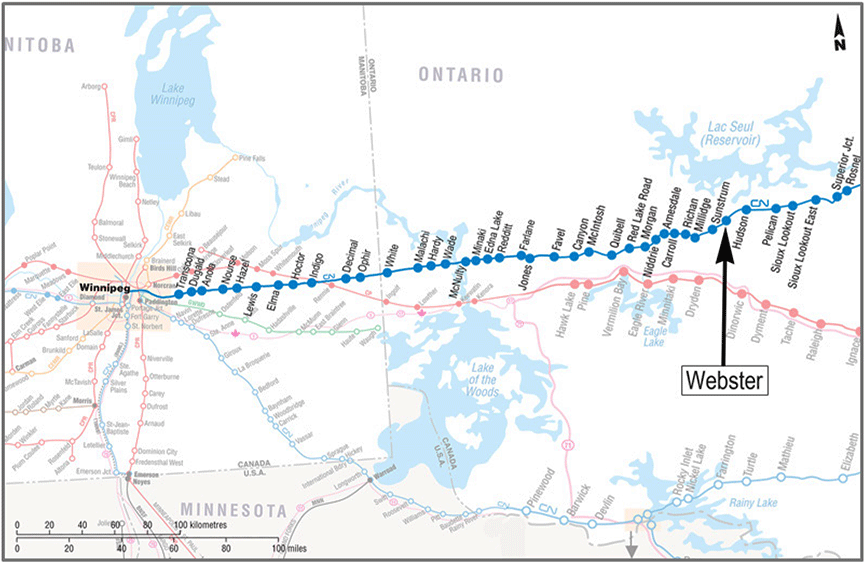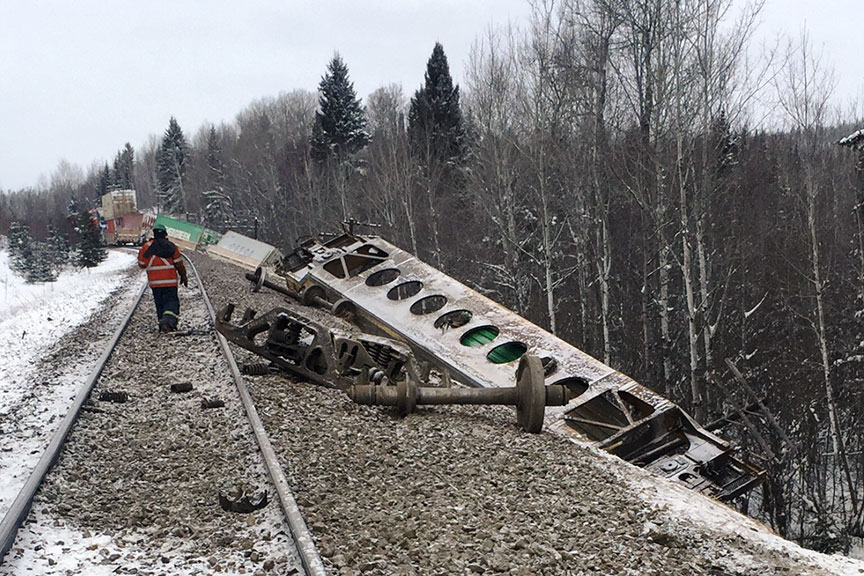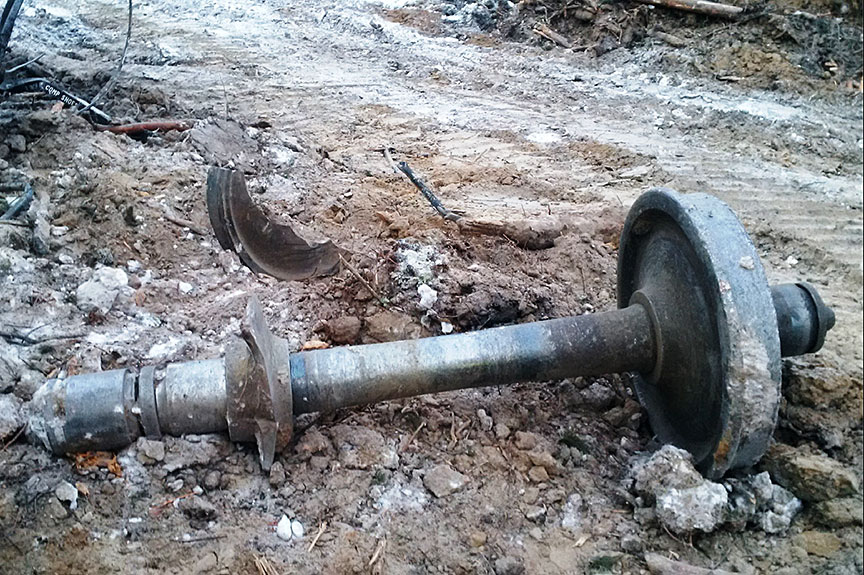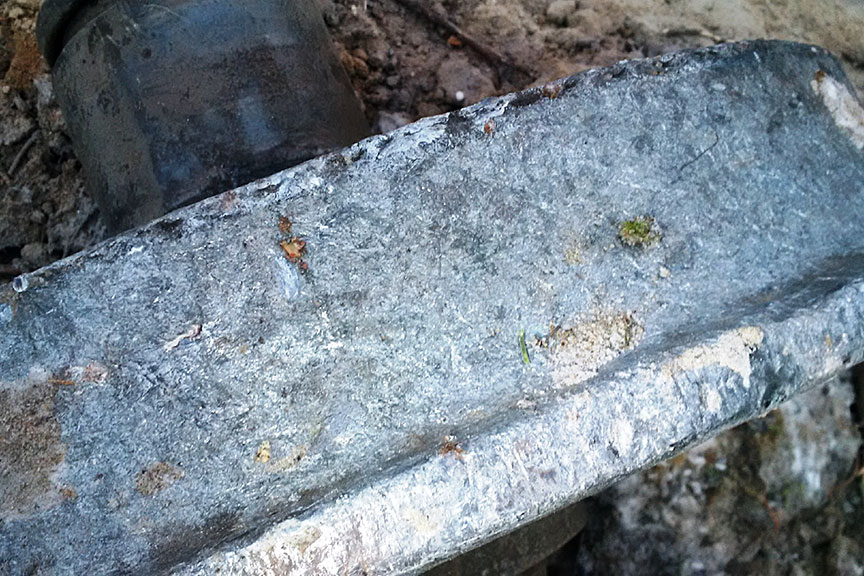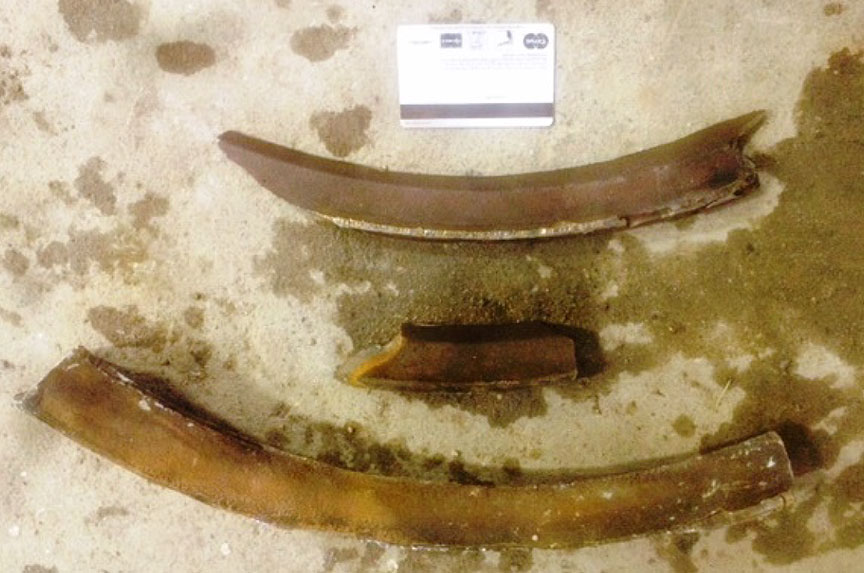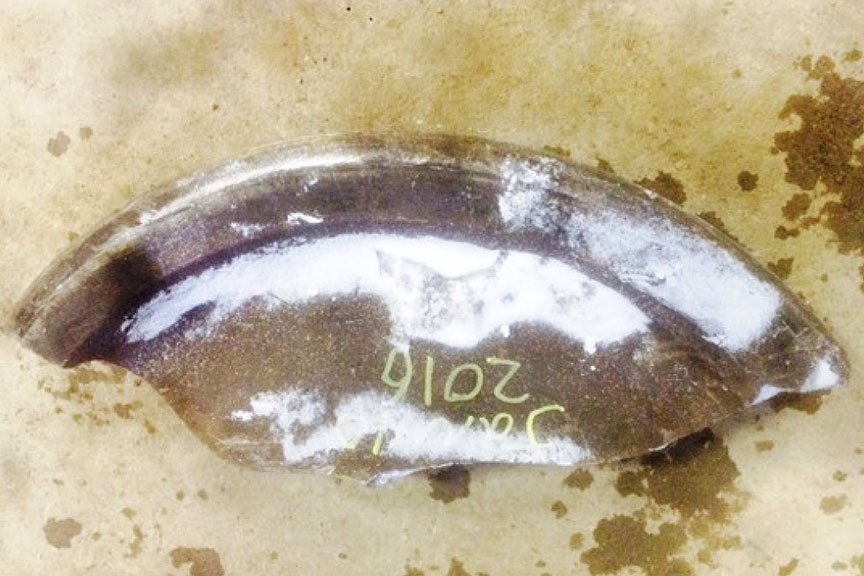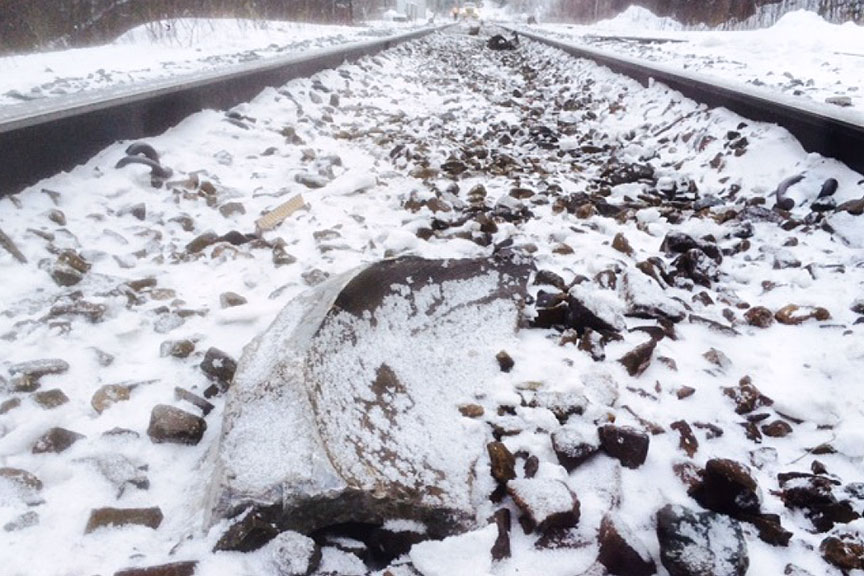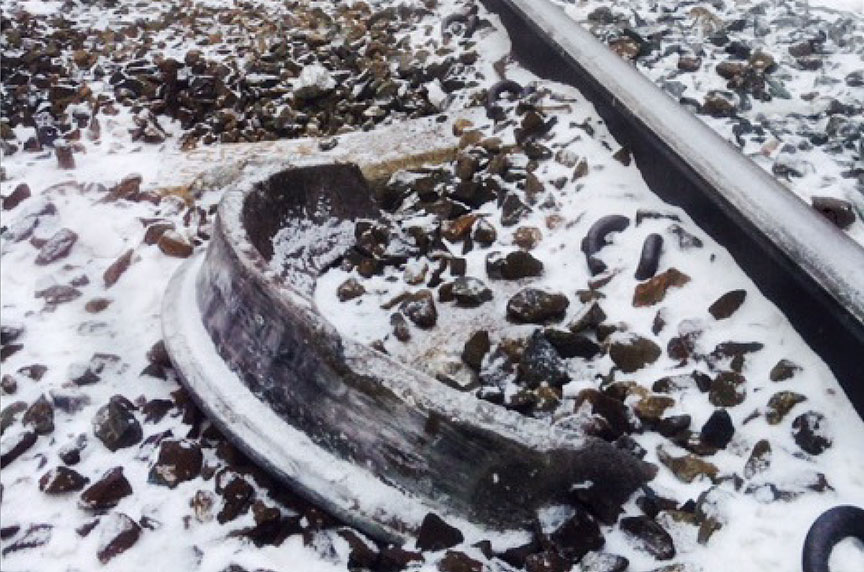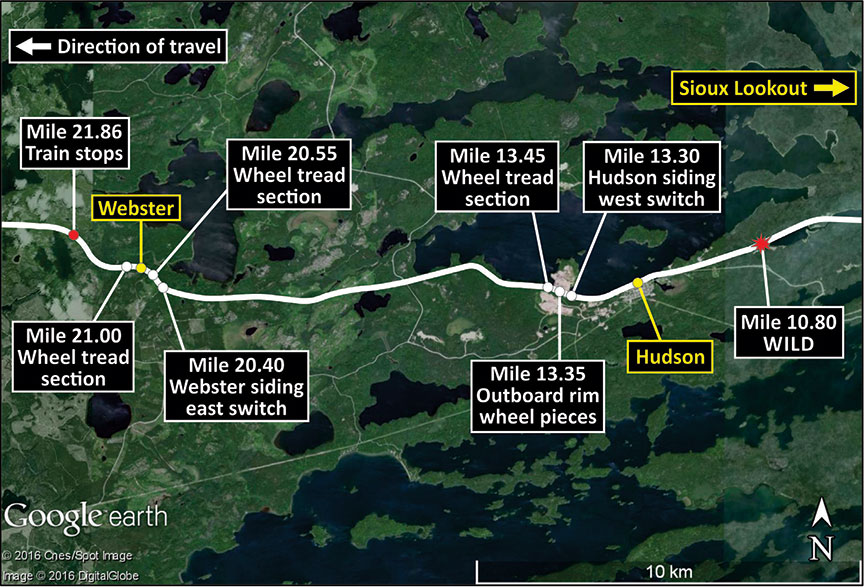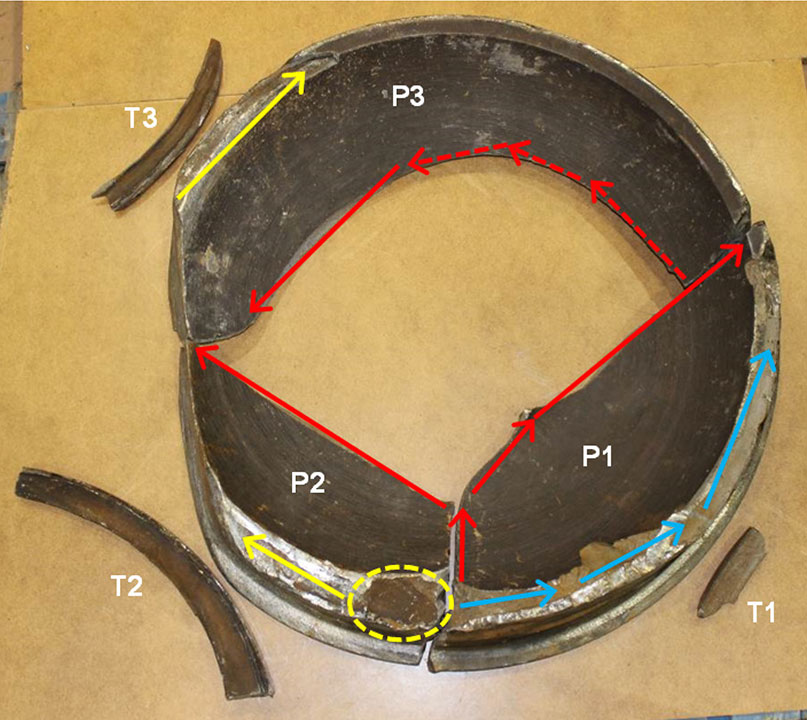Main-track train derailment
Canadian National Railway Company
Freight train M31331-07
Mile 13.45, Redditt Subdivision
Webster, Ontario
The Transportation Safety Board of Canada (TSB) investigated this occurrence for the purpose of advancing transportation safety. It is not the function of the Board to assign fault or determine civil or criminal liability. This report is not created for use in the context of legal, disciplinary or other proceedings. See Ownership and use of content. Masculine pronouns and position titles may be used to signify all genders to comply with the Canadian Transportation Accident Investigation and Safety Board Act (S.C. 1989, c. 3).
Summary
On 09 January 2016, at 0802 Central Standard Time, Canadian National Railway Company freight train M31331 07 was proceeding westward on the Redditt Subdivision at about 46 mph when a train-initiated emergency brake application occurred at Mile 21.74, near Webster, Ontario. Subsequent inspection determined that a total of 26 cars (29 platforms) had derailed. The derailed cars included 6 Class 111 dangerous goods residue tank cars that had last contained diesel fuel (UN 1202). There were no injuries and no product was released.
Le présent rapport est également disponible en français.
Factual information
On 09 January 2016, Canadian National Railway Company (CN) freight train M31331‑07 (the train) departed Sioux Lookout, Ontario, destined for Winnipeg, Manitoba. The mixed manifest train was composed of 3 head-end locomotives, 22 loaded cars, 6 empty cars, and 24 residue tank cars. The train weighed 4143 tons and was 3713 feet long. The crew consisted of a locomotive engineer and a conductor. Both crew members were qualified for their respective positions, were familiar with the territory, and met established fitness and rest standards.
The accident
At 0802,Footnote 1 the train was proceeding westward at about 46 mph on the CN Redditt Subdivision when an undesired train-initiated emergency brake application occurred at Mile 21.74, near Webster, Ontario (Figure 1).
Site inspection determined that the 1st to the 26th cars from the head-end locomotives (29 platforms in total) had derailed. The derailed cars included 6 Class 111 dangerous goods residue tank cars that had last contained diesel fuel (UN 1202). No product was released and there were no injuries.
At the time of the occurrence, there were light snow flurries and the temperature was −18 °C.
Site examination
The derailment occurred on tangent track. The derailed cars came to rest in various positions along the right-of-way. The 1st car from the head end was a 5-platform intermodal car (DTTX 760234) that came to rest near Mile 21.86. The car's 1st platform behind the locomotives did not derail, but the 4 trailing platforms derailed down the embankment on the north side of the track.
The 2nd car from the head end was loaded intermodal car DTTX 469967. A wheel set with a broken 33-inch wheel was located on the north side of the track adjacent to the overturned car (Photo 1). The broken wheel was from the L1 position of the leading B-end truck of car DTTX 469967.
Before the derailment, the wheel had been running on the north rail. Although this was the 5th derailed platform, it was the 1st car to derail. Car DTTX 469967 overturned and derailed down the embankment on the north side of the track. In the process, it pulled off the 4 trailing platforms of the 1st car from the head end (DTTX 760234).
Broken wheel
The 33-inch L1 wheel had been manufactured in February 2012 by the Griffin Wheel Company in Kansas City, Missouri. It was a 1-wear, heat-treated Class C cast wheel. The wheel set had been assembled in March 2012 by Progress Rail in Mojave, California, and placed in service on car DTTX 469967 in April 2012.
On 07 January 2016, 2 days before the incident, impact readings for the L1 wheel had been recorded at 5 CN wheel impact load detector (WILD) sites while the car was travelling at or near track speed. None of these recorded impacts exceeded 70 kips.Footnote 2
At 0748, about 14 minutes before the occurrence, the train was proceeding at 47 mph when it traversed the CN WILD site at Hudson, Ontario (Mile 10.80), where the L1 wheel of car DTTX 469967 recorded an actual impact of 99.3 kips.
An initial examination of the L1 wheel and the No. 1 wheel set determined that
- there were several wheel tread separations;
- the hub of the fractured wheel was still on the axle, but it had moved inward off of the axle wheel seat (Photo 2); and
- the mate wheel tread displayed mechanical damage consistent with having been in contact with the ground for an extended period of time (Photo 3).
Between Mile 13.35 and Mile 21.00, 6 wheel pieces that had separated from the 33‑inch L1 wheel were recovered:
- 3 small pieces of the outboard rim located at Mile 13.35 (Photo 4);
- a 1st wheel tread section with a portion of the wheel plate located at Mile 13.45 (Photo 5);
- a 2nd wheel tread section with a portion of the wheel plate located at Mile 20.55 (Photo 6); and
- a 3rd wheel tread section with a portion of the wheel plate located at Mile 21.00 (Photo 7).
Starting at Mile 13.45, where the first wheel tread section broke away from the wheel plate, impact marks from the derailed wheel were observed on the track infrastructure extending westward. The train had continued until the derailed No. 1 wheel set contacted the track work associated with the Webster siding east switch at Mile 20.40.
Figure 2 identifies the location of the CN Hudson WILD site, the various locations at which pieces of the L1 wheel were recovered, and the location where the train stopped.
The No. 1 wheel set and the recovered pieces of the L1 wheel were sent to the TSB Engineering Laboratory for detailed examination.
Intermodal car DTTX 469967
Car DTTX 469967 was a stand-alone intermodal well car built in July 1974. It measured 76 feet 10 inches long and had a maximum gross rail load of 220 000 pounds. The car had a tare weight (empty) of 58 100 pounds and a load limit of 161 900 pounds. On the occurrence trip, the loaded car weighed 201 842 pounds.
Subdivision information
The CN Redditt Subdivision starts at Sioux Lookout (Mile 0.0) and extends westward to Winnipeg (Mile 252.1). Train movements on the subdivision are governed by the centralized traffic control system as authorized by the Canadian Rail Operating Rules and supervised by a rail traffic controller (RTC) located in Toronto, Ontario. The authorized track speed for westbound freight trains through the area of the derailment was 45 mph. At the time of the occurrence, there were no slow orders in effect.
The track was classified as Class 4 track according to the Transport Canada (TC)–approved Rules Respecting Track Safety, which are also referred to as the Track Safety Rules. In 2015, an average of 16 freight trains per day traversed the Redditt Subdivision, and cumulative rail traffic for the year was 42.4 million gross ton-miles per mile.
Track information
The track at Mile 13.45 was tangent with a 0.1% ascending grade in the direction of travel (westward). The track consisted of 136-pound continuous welded rail on 14-inch double‑shouldered tie plates with spring clips. The ties were concrete with approximately 2640 ties per mile, and were supported by ballast as per CN standard.
The most recent track geometry test before the accident was performed by CN test car 1057 on 31 October 2015. During this inspection, no urgent or near-urgent track defects were identified in the vicinity of Mile 13.45. On 01 January 2016, the track was ultrasonically tested by Sperry Rail Service test car 760. No rail anomalies were detected in the vicinity of the derailment. On 08 January 2016, the track supervisor conducted a visual inspection with no exceptions noted in the vicinity of Mile 13.45.
Wheel impact load detectors
The development and implementation of WILD technology was an industry initiative to enhance rail safety by proactively identifying wheels with tread defects that can generate high impact loads. The intent is that suspect wheels will be removed before they cause damage to track infrastructure or rolling stock components, or before the wheel fails in service.
WILD systems are usually installed on tangent track with a track speed of 50 mph and are intended to record the measured impact at track speed. The measured wheel impact force is directly related to speed: the faster the train travels, the greater the measured wheel impact will be if a wheel tread defect is present. Likewise, the slower a train travels through a WILD site, the lower the measured wheel impact will be.
The impact load of a wheel on the rail is measured through either a strain-based system or an accelerometer-based system. The strain-based system estimates the force applied to the rail using a mathematical relationship between the applied load and the deflection at the base of the rail. The strain gauges are physically mounted on the web of rail, about halfway down from the top of the rail head. Strain in the rail is used as a direct measure of the load at the rail head.
The TC-approved Railway Freight Car Inspection and Safety Rules do not have any provisions for condemning in-service wheels due to high wheel impact loads. There are currently no regulatory requirements or guidance on the WILD thresholds used in Canada or the United States.
In response to the TSB Rail Safety Advisory Letter 11/11, "Broken Wheels with Previous AAR Condemnable WILD Readings," TC indicated that
- it would be creating a joint TC–industry forum to undertake a comprehensive review of wayside inspection systems and WILD criteria; and
- it may, based on this review, create guidelines, standards, or rules governing the use of wayside inspection systems, including WILD.
As of October 2016, there had not been any progress by TC regarding guidelines, standards or rules for the use of WILD technology.
Association of American Railroads wheel impact load detector removal thresholds
Rule 41 of the Association of American Railroads (AAR) 2016 Field Manual of the AAR Interchange Rules states in part
Rule 41
STEEL WHEEL DEFECTS—OWNER'S RESPONSIBILITY
A.1. Condemnable at Any Time
[…]
r. Wheel Out-of-Round or 90,000 Pounds (90 kips) or Greater Maximum Peak Impact.
(1) Detected by a wheel impact load detector reading 90,000 pounds (90 kips) or greater for a single wheel. The detector used must meet the calibration and validation requirements of MSRP [Manual of Standards and Recommended Practices] Section F, Standard S-1601. The detector must reliably measure peak impacts and must provide a printable record of such measurements. Device calibration records must be maintained. Wheels with condemnable slid flat spot(s) are handling line responsibility and must not be billed otherwise.
[…]
A.2. Condemnable When Car Is on Shop or Repair Track for Any Reason
[…]
e. Detected by a Wheel Impact Load Detector reading a Maximum Peak from 80 kips to less than 90 kips for a single wheel. The detector used must have been calibrated per MSRP Section F, Standard S-1601. The detector must reliably measure peak impact and must provide a printable record of such measurements. Device calibration records must be maintained. Wheels with condemnable slid flat spots are handling line responsibility and must not be billed otherwise. This will be considered an Opportunistic Repair for the repairing party. Wheels removed for this condition are not to be stenciled SCRAP as referenced in Rule 41.E.8.c.
The AAR Wheels, Axles, Bearings and Lubrication Committee was responsible for the development and implementation of Rule 41. Its decision to use 90 kips as the condemning limit was based on a number of technical studies conducted in the early 1990s.Footnote 3 Engineering analysis from these studies supports 90 kips as a reasonable wheel-removal threshold that would help limit the damage to both equipment and track infrastructure.
Railway wheel impact load detector thresholds
In addition to the AAR condemning limits for wheel impacts, railways have developed their own wheel-removal thresholds. Typically, these thresholds are not based on engineering analysis but on each railway's operating practices and conditions as well as its capacity to manage the volume of wheels removed for WILD impacts. The WILD removal thresholds for each railway vary throughout the industry and have evolved over time.
Railway WILD thresholds evaluate the measured impact and the calculated impact for a given wheel. The measured impact is the actual wheel impact force recorded at track speed, which is usually 50 mph. Canadian Class I railways also typically adjust the measured impact value using a speed-corrected algorithm to produce a calculated impact value. The use of this algorithm is a proactive measure that takes the actual impact level at a slower speed and uses linear regression to estimate it as an impact at 50 mph. This calculation allows the railway to evaluate all wheel impacts at a normalized speed of 50 mph.
However, each railway's algorithm may vary and is sensitive to wheel defect type, low speed conversion, and assumed linearity. For these reasons, the calculated impact value is not considered to be as accurate as the measured impact value, and there is no common AAR condemning limit established for calculated values.
Canadian railway company wheel impact load detector thresholds
Canadian National Railway Company guidelines for freight car wheel impact load detector alerts and alarms
CN has the following WILD alarm threshold requirements for measured (peak) impacts of 140 kips or greater:
- For cars with a single measured impact over 160 kips, or 200 kips for a calculated impact, the RTC must immediately restrict the speed of the train to 25 mph. If the recorded impact is on an inbound train, the car must be set out at the terminal. If the recorded impact is on an outbound train, the car must be set out at the first designated siding. The car will be bad-orderedFootnote 4 with Code WI by the RTC mechanical service representative (RTC Mech), who will advise the responsible repair personnel.
- For cars with a single measured impact between 150 and 159 kips, the RTC must immediately restrict the speed of the train to 10 mph less than the speed recorded at the WILD site. The RTC will then decide whether the car should be set out at the inbound terminal (if inbound) or at the first designated set-out location (if outbound). If neither set-off location is practical, the car can be moved to another convenient location for set-off but should never move beyond the next location, where it will receive a certified car inspection (CCI). The car will be bad-ordered with Code WI by the RTC Mech, who will advise the responsible repair personnel.
- For cars with a single measured impact between 140 and 149 kips, the RTC must immediately restrict the speed of the train to 5 mph less than the speed recorded at the WILD. If the temperature at the WILD is −25 °C (−13 °F) or colder, the speed reduction must be 10 mph less than the speed recorded at the WILD. The RTC will then decide whether the car should be set out at the inbound terminal (if inbound) or at the first designated set-out location (if outbound). If neither set-off location is practical, the car can be moved to another convenient location for set-off but should never move beyond the next location, where it will receive a CCI. The car will be bad-ordered with Code WI by the RTC Mech, who will advise the responsible repair personnel.
In each of the above situations, the subject wheel must be replaced before the car is placed back into service.
In addition to the WILD thresholds for measured (peak) impacts greater than 140 kips, CN has maintenance guidelines for handling cars with measured (peak) impacts between 80 and 139 kips. The guidelines specify the following:
- Cars arriving from interchange to CN with off-line previously recorded wheel impacts are automatically identified.
- For impacts between 80 and 89 kips, wheel sets are to be removed when a car is on a shop or repair track, as per AAR Rule 41, and these are considered opportunistic repairs.
- Although wheel sets with recorded impacts between 90 and 139 kips are condemnable at any time under AAR Rule 41, CN treats these as opportunistic repairs, and the wheel sets are removed when the car is empty or loaded at the next CCI location.
Canadian Pacific Railway guidelines for wheel impact load detector thresholds
Canadian Pacific Railway (CP) has developed and implemented the following guidelines for WILD alarm thresholds:
- For northern Ontario, CP requires a car to be bad-ordered immediately for measured wheel impacts of 130 kips or greater or calculated wheel impacts of 150 kips or greater.Footnote 5
- For the remainder of the CP system, the WILD guidelines require a car to be bad‑ordered immediately for measured wheel impacts of 140 kips or greater or calculated wheel impacts of 170 kips or greater. When a car is bad-ordered, the train speed is reduced, and the car is set off at the next designated location for repair.
- For calculated impacts of 100 kips or greater, CP requires the car to be bad‑ordered when empty. This allows the car to proceed to its destination with no restrictions and to be repaired once it is empty.
- For calculated impacts of between 90 and 110 kips, CP has a number of opportunistic threshold limits (OP1 to OP4). In these situations, CP flags the car in its car information management system, but does not bad-order the car. The car can proceed to its destination without restrictions and may be repaired when operationally convenient. However, the car may also return to service without removal of the subject wheel set.
TSB Engineering Laboratory examination
The TSB Engineering Laboratory conducted a detailed examination of the failed L1 wheel from car DTTX 469967 and made the following determinations:
- The 33-inch wheel was within the AAR limits for flange width, vertical flange height and rim thickness.
- The hardness and chemical composition of the 33-inch wheel met the AAR specifications for Class C wheels.
- Based on wet magnetic particle inspection of the wheel pieces, no crack indications were observed on the outboard face of the wheel plate.
- The failure of the wheel was facilitated by the presence of a vertical split rim (VSR) that had originated below the tread surface. The VSR extended approximately 43¾ inches around the wheel circumference (Figure 3).
- At some point before the occurrence, VSR cracking initiated about ½ inch below the wheel tread. Identification of the origin was not possible due to significant post‑failure damage.
- The VSR crack subsequently propagated down into the rim toward the wheel plate.
- A piece of tread face corresponding to the initial VSR fracture likely separated from the wheel before Mile 13.35 but was not recovered.
- The VSR crack propagated circumferentially away from the initial fracture, in a progressive mode on one side and in overstress on the other side, resulting in the separation of 3 pieces of wheel rim at Mile 13.35.
- Once the pieces of wheel rim broke off the wheel, the impact load on the wheel increased significantly, likely resulting in the overstress fracture of the plate and the separation of the piece labelled P1 in Figure 3 at Mile 13.45.
- The overstress fracture propagated to the wheel bore, which caused the wheel hub to lose its interference fit with the axle and move inboard of the rail. In addition, the mating wheel likely moved inboard of the rail at about this time.
- The remaining portion of the L1 wheel was dragged over the ties and ballast, causing the wear pattern observed on the tread of the pieces labelled P2 and P3 in Figure 3. These pieces eventually separated and were recovered at Mile 20.55 and Mile 21.00, respectively, near where the derailed cars came to rest, at Mile 21.86.
Vertical split rim wheel failure
The VSR wheel failure phenomenon continues to be studied by the rail industry and is not yet fully understood. This type of wheel failure—which can be initiated by tread surface conditions, including checking, spallsFootnote 6 or shellsFootnote 7—tends to originate from the bottom of a tread defect.
Research into wheel residual stress patterns and VSR failures has determined that service-worn Class C wheels exhibit compressive residual stress at the wheel tread, which is balanced by tensile axial stresses deeper in the rim.Footnote 8 When cracks from the tread surface propagate into this sub-surface axial tensile zone, VSR failure can occur under additional service loads. Wheels that may have VSRs and that record impacts do not always exhibit significant wheel tread damage. In these situations, deterioration of the wheel tread surface can sometimes occur rapidly and may not always be detected by a WILD.
The Transportation Technology Center, Inc. (TTCI) conducted a studyFootnote 9 that examined 24 broken wheels and identified VSR as the failure mode for 17 (71%) of these wheels. Historical WILD data were available for 12 of the examined broken wheels. Of these 12 wheels, 6 had recorded an impact load that exceeded 90 kips prior to failure.
Previous derailments related to wheel impacts
Rail steel is known to have reduced fracture toughness and ductility at low temperatures, particularly if a rail defect, which can act as a stress raiser, is present. It is also recognized by the industry that wheels producing high impact loads may cause damage to equipment (such as wheels, axles, bearings, and journals) and to track infrastructure, primarily in the form of broken wheels and broken rails, respectively.
The TSB has conducted detailed follow-up on 7 occurrences (including this derailment) that were caused by either broken wheels or broken rails resulting from wheel impacts (Appendix A). In all 7 of the occurrences, railway WILD records had identified cars with recorded impacts that exceeded the AAR WILD removal threshold (90 kips) but were below the railway's WILD thresholds or wheel set removal thresholds. In 5 of these occurrences, wheels with VSR failures were involved. Because there are no regulations, rules, or guidelines requiring the removal of a wheel for a recorded impact, the wheel sets had remained in service and subsequently caused a derailment.
TSB laboratory report
The following TSB laboratory report was completed in support of this investigation:
- LP 023/2016—Examination of Wheelset
Analysis
The train was handled in accordance with regulations and company instructions. There were no track defects in the vicinity of the occurrence that could be considered causal or contributory. The analysis will focus on the broken L1 wheel from intermodal car DTTX 469967, the detection of potential vertical split rim (VSR) wheel failures, and the regulatory oversight of wheel impact load detector (WILD) thresholds.
The accident
The accident occurred when the L1 wheel on the 2nd car from the head end (DTTX 469967) failed progressively from a VSR that had been present for some time. The VSR crack propagated circumferentially for 43¾ inches from the initial fracture, and resulted in 3 pieces of rim separating from the wheel at Mile 13.35.
The resulting gap in the tread surface of the wheel led to high cyclical impacts, promoting the propagation of an overstress brittle fracture and the separation of a larger wheel tread/plate section. The overstress fracture then propagated to the wheel bore, which resulted in the L1 wheel losing its interference fit with the axle wheel seat and allowed the wheel to move inboard on the axle, drop between the rails, and derail at Mile 13.45 (the initial point of derailment).
The remaining portion of the L1 wheel was dragged over the ties and ballast until the derailed No. 1 wheel set contacted the track work associated with the Webster siding east switch at Mile 20.40. With 2 larger pieces of the wheel tread/plate separating at Mile 20.55 and Mile 21.00, a train-initiated emergency brake application occurred at Mile 21.74, and the head end of the train came to rest at Mile 21.86 with the trailing 26 cars (29 platforms) derailed.
Broken L1 wheel on car DTTX 469967
The dimensional attributes of the L1 wheel on car DTTX 469967 were within the Association of American Railroads (AAR) limits for wear. The mechanical properties and the chemical composition of the wheel met the AAR specification for Class C wheels.
Although the VSR was present in the L1 wheel for some time prior to the failure, the VSR had developed below the wheel tread surface, which made detection unlikely. Consequently, there were no condemnable WILD impacts recorded for the L1 wheel before 09 January 2016. However, at 0748, about 14 minutes before the accident, the L1 wheel recorded an actual impact of 99.3 kips at the CN WILD site at Hudson (Mile 10.80). Although the recorded impact exceeded the AAR Rule 41 WILD condemning criteria of 90 kips, it did not meet the CN WILD guideline of 160 kips and did not require any immediate action under CN WILD guidelines.
With no regulatory requirements or guidance for WILD thresholds, the railway's WILD guidelines were followed, and the car was allowed to proceed to its destination. Despite the LI wheel recording an impact at the CN WILD site at Hudson (Mile 10.80) that was condemnable under AAR Rule 41, CN WILD guidelines permitted the L1 wheel on car DTTX 469967 to remain in service. The wheel failed shortly thereafter, about 2½ miles west of the WILD site.
Vertical split rim wheel failures
The TSB has conducted detailed follow-up on 7 occurrences (including this derailment) that were caused by either broken wheels or broken rails resulting from wheel impacts. In all 7 of the occurrences, railway WILD records had identified cars with recorded impacts that exceeded the AAR WILD removal criteria (90 kips) but were below the railway's WILD thresholds or wheel set removal thresholds. In 5 of these occurrences, the wheels subsequently failed as a result of a VSR. Because there are no regulations, rules, or guidelines requiring the removal of a wheel for a recorded impact, the cars and wheel sets had remained in service and subsequently caused a derailment.
A study conducted by the Transportation Technology Center, Inc. (TTCI) examined 24 broken wheels and determined that VSR was the wheel failure mode for 17 (71%) of these wheels. In addition, the study reviewed available WILD data for 12 of the broken wheels and found that 6 (50%) of these had recorded impact loads greater than 90 kips before the wheel failed.
A number of TSB investigations, detailed follow-up on several TSB occurrences involving a wheel failure, and the TTCI study show that there have been at least 11 verified derailments in which a VSR wheel failure occurred after the wheel recorded an impact greater than 90 kips that was condemnable under AAR Rule 41. In each of these 11 occurrences, the railway's WILD guidelines permitted the wheel to remain in service without requiring any immediate action.
While the VSR wheel failure phenomenon continues to be studied and is not yet fully understood, there have been 11 instances of measured WILD impacts in excess of 90 kips associated with the subsequent VSR failure of the wheel.
Association of American Railroads and Canadian National Railway Company wheel impact load detector thresholds
The development and installation of WILD systems was primarily an industry initiative. These systems provide an additional level of safety, complementing visual train inspections performed by railway personnel. As a preventive tool, WILD systems identify high impact wheels so that they can be removed before causing damage to the track infrastructure or the rolling stock.
AAR Rule 41 indicates that a wheel that records a measured (actual) WILD impact of 90 kips (or greater) is condemnable at any time. This means that the railway can stop the train, set out the car, remove and replace the wheel, and recover wheel change-out costs from the car owner. Similarly, any wheel with a measured WILD impact from 80 kips to less than 90 kips is condemnable when the car is on a shop or repair track for any reason.
In comparison, CN automatically places an alert on a car and bad-orders it in the system for measured impacts of 90 to 139 kips. However, the alert or bad-order status of the car remains dormant or is not identified until the car reaches its certified car inspection location, which, in some cases, can be its final destination. While the car is proceeding to that location, no restrictions would normally be placed on it.
As demonstrated in TSB investigations and a TTCI study, wheels that record an AAR condemnable impact in excess of 90 kips, yet are permitted to remain in service under railway guidelines, can progress to failure due to an undetected VSR.
If railway WILD guidelines do not provide adequate guidance for dealing with wheel impacts that are condemnable under AAR Rule 41, there is an increased risk that wheels with emerging defects, such as a VSR, will not be identified and removed from service before progressing to failure.
Regulatory oversight
CN has one of North America's most comprehensive networks of WILDs. The increased use of WILD technology has improved railway safety, as demonstrated by the volume of wheel sets removed by CN under its own condemnable WILD criteria as well as those of AAR Rule 41. Despite these improvements, in-service wheel failures continue to occur and sometimes result in derailments.
Although causal links have long been established between high wheel impact loads and rail failures, the discussion around WILD technology has primarily focused on what the wheel-removal threshold should be. According to AAR Rule 41, a wheel that records a measured (actual) WILD impact of 90 kips (or greater) is condemnable at any time, and a wheel with a measured WILD impact from 80 kips to less than 90 kips is condemnable when the car is on a shop or repair track for any reason. These AAR thresholds are based on engineering analysis that supports them as reasonable wheel-removal thresholds to help limit the damage to equipment and track infrastructure.
In comparison, industry WILD thresholds and wheel-removal protocols vary between companies. CN requires immediate intervention for cars with a single measured impact over 160 kips, or a calculated impact of 200 kips. Canadian Pacific Railway (CP) requires a car to be bad-ordered immediately for measured wheel impacts of 130 kips or greater or calculated wheel impacts of 150 kips or greater when operating in northern Ontario, and measured wheel impacts of 140 kips or greater or calculated wheel impacts of 170 kips or greater throughout the rest of Canada.
Railway WILD thresholds can be up to 75% higher than the AAR Rule 41 condemning limit of 90 kips. These WILD thresholds were established primarily by industry practice based on operational needs, rather than on engineering analysis, and were set at a level that makes it easier to manage the volume of wheels removed for WILD impacts. WILD removal thresholds for each railway vary throughout the industry.
The Transport Canada (TC)–approved Railway Freight Car Inspection and Safety Rules have no provisions for condemning wheels due to recorded high impacts. Furthermore, there are currently no regulatory requirements or guidelines in Canada or the United States on the use of wayside inspection systems, including WILDs. Consequently, the location of WILD sites, the distance between them, and the intervention thresholds differ for each railway. Railways can also alter WILD thresholds at any time to meet operational needs.
Although TC had indicated that it would create a joint forum to conduct a comprehensive review of wayside inspection system and WILD criteria, as of October 2016, there had not been any progress by TC regarding guidelines, standards, or rules for the use of WILD technology.
In the absence of WILD condemning limits within the TC-approved Railway Freight Car Inspection and Safety Rules and/or other related TC guidance, company WILD guidelines may not be sufficiently robust to consistently protect against wheel failures.
Findings
Findings as to causes and contributing factors
- The accident occurred when the L1 wheel on the 2nd car from the head end (DTTX 469967) failed progressively from a vertical split rim that had been present for some time.
- The vertical split rim crack propagated circumferentially for 43¾ inches from the initial fracture, and resulted in 3 pieces of rim separating from the wheel at Mile 13.35.
- The resulting gap in the tread surface of the wheel led to high cyclical impacts, promoting the propagation of an overstress brittle fracture and the separation of a larger wheel tread/plate section.
- The overstress fracture then propagated to the wheel bore, which resulted in the L1 wheel losing its interference fit with the axle wheel seat and allowed the wheel to move inboard on the axle, drop between the rails, and derail at Mile 13.45 (the initial point of derailment).
- The remaining portion of the L1 wheel was dragged over the ties and ballast until the derailed No. 1 wheel set contacted the track work associated with the Webster siding east switch at Mile 20.40.
- With 2 larger pieces of the wheel tread/plate separating at Mile 20.55 and Mile 21.00, a train-initiated emergency brake application occurred at Mile 21.74, and the head end of the train came to rest at Mile 21.86 with the trailing 26 cars (29 platforms) derailed.
- Although the vertical split rim (VSR) was present in the L1 wheel for some time prior to the failure, the VSR had developed below the wheel tread surface, which made detection unlikely.
- Despite the recorded wheel impact that was condemnable under Association of American Railroads Rule 41 at the Canadian National Railway Company wheel impact load detector (WILD) site at Hudson (Mile 10.80), company WILD guidelines permitted the L1 wheel on car DTTX 469967 to remain in service, and the wheel failed shortly after, about 2½ miles west of the WILD.
Findings as to risk
- If railway wheel impact load detector guidelines do not provide adequate guidance for dealing with wheel impacts that are condemnable under Association of American Railroads Rule 41, there is an increased risk that wheels with emerging defects, such as a vertical split rim, will not be identified and removed from service before progressing to failure.
Other findings
- The dimensional attributes of the L1 wheel on car DTTX 469967 were within the Association of American Railroads limits for wear.
- The mechanical properties and the chemical composition of the wheel met the Association of American Railroads specification for Class C wheels.
- There have been 11 instances of measured wheel impact load detector impacts in excess of 90 kips associated with the subsequent vertical split rim failure of the wheel.
- In the absence of wheel impact load detector (WILD) condemning limits within the Transport Canada–approved Railway Freight Car Inspection and Safety Rules and/or other related Transport Canada guidance, company WILD guidelines may not be sufficiently robust to consistently protect against wheel failures.
Safety action
Action taken
The Board is not aware of any specific safety action taken following this occurrence.
This report concludes the Transportation Safety Board's investigation into this occurrence. The Board authorized the release of this report on 04 January 2017. It was officially released on 29 March 2017.
Appendices
Appendix A – Previous derailments relating to wheel impacts
TSB Investigation Report R99H0010: On 30 December 1999, Canadian National Railway Company (CN) freight train U-783-21-30 was travelling westward on the north track of the Saint-Hyacinthe Subdivision. At Mile 50.84, near Mont-Saint-Hilaire, Quebec, the train derailed, and cars fouled the adjacent south main track. At about the same time, CN freight train M-306-31-30 was travelling eastward on the south track and collided with the cars of train U-783-21-30, which had just derailed. Two crew members on train M-306-31-30 were fatally injured in the accident.
The investigation determined that an existing pre-crack in the south rail of the north track was sufficient to initiate rail failure, given the effect of stresses induced on the rail by the combination of low ambient temperatures and wheel impact loads of 103 to 112 kips, which were above Association of American Railroads (AAR) condemning criteria, but below CN's wheel impact load detector (WILD) thresholds.
TSB occurrence R03T0030Footnote 10: On 23 January 2003, while travelling at 34 mph, Canadian Pacific Railway (CP) freight train 213-22 (23 loads, 69 empties) derailed 29 cars at Mile 78.2 of the White River Subdivision, in Ontario. The temperature at the time of the occurrence was −20 °C.
The derailment occurred when the R2 wheel on the 10th car from the head end sustained a vertical split rim (VSR) failure. Impacts from the broken wheel caused the south rail to fail, resulting in the derailment. Two days previously, the same wheel had recorded a measured impact of 99 kips while travelling at a speed of 30 mph, which equates to a calculated impact of 136.5 kips. Although the measured impact force was above the AAR's Rule 41 condemning limit of 90 kips, both the measured and calculated impacts were below CP's WILD removal thresholds. Consequently, no maintenance action was initiated for the wheel set after the impact measurement.
TSB Investigation Report R03T0064: On 02 February 2003, while travelling at about 37 mph, CP freight train 938-12 was inspected at a WILD site near Raith, Ontario, about 59 miles (95 km) west of Thunder Bay, Ontario. Although there were no wheel impacts greater than 140 kips, 4 of the recorded impacts were between 90 kips and 116 kips, equating to calculated impacts of between 109 kips and 144 kips. Although the measured impacts were above the AAR's Rule 41 condemning limit of 90 kips, both the measured and calculated impacts were below CP's WILD removal thresholds. No maintenance action was taken or required.
On 13 February 2003, the same train was proceeding southward at about 42 mph when 21 of its cars derailed at Mile 39.5 of the Parry Sound Subdivision near Nobel, Ontario. The investigation determined that wheel impacts had likely initiated a brittle fracture from the root of a pre-crack through the base of the rail, facilitating the final catastrophic rail failure.
TSB Investigation Report R11V0039: On 12 February 2011, CN coal train C-751-51-11 was travelling westward on the Nechako Subdivision at about 45 mph when a train‑initiated emergency brake application occurred at Mile 93.45, near Fort Fraser, British Columbia. A total of 36 cars derailed.
The derailment occurred when the L2 wheel on car BCNE 900534 failed catastrophically after sustaining a VSR failure.Footnote 11 The fracture originated at the base of a shell that had developed as a result of rolling contact fatigue and extended through the unsupported portion of the wheel tread throughout one fourth of the wheel circumference.
Less than 3 hours before the derailment, the wheel recorded a WILD reading of 94.4 kips at a WILD site located about 78 miles ahead of the derailment site. On 3 other occasions in the previous 1½ months, the same wheel had recorded impacts of over 80 kips. The investigation determined that company WILD policies may not provide adequate guidance to identify emerging wheel defects when wheel impacts are above the AAR Rule 41 condemning limits but below company thresholds.Footnote 12
TSB occurrence R11T0072: On 27 March 2011, CN freight train M30511-26, transporting 97 loaded and 19 empty cars, was proceeding westward at about 50 mph on the Kingston Subdivision when a train-initiated emergency brake application occurred, and 25 cars derailed near Port Hope, Ontario (Mile 268.50). The derailment occurred when the R4 wheel on tank car PROX 43452 failed catastrophically after sustaining a VSR failure. The fracture originated at the base of a shell, about ¼ inch below the tread surface. The fracture origin developed as a result of rolling contact fatigue, and extended through the unsupported portion of the wheel tread throughout one fourth of the wheel circumference.Footnote 13
Between 29 December 2010 and 27 March 2011, the R4 wheel on car PROX 43452 had recorded 5 WILD impacts that exceeded the AAR Rule 41 condemnable limit of 90 kips. These impacts included a reading of 94.2 kips on the day of the derailment. Despite multiple WILD readings that exceeded AAR WILD thresholds, and a number of opportunities for a targeted inspection and/or removal of the wheel in the 3 months preceding the accident, the wheel remained in service until it failed.Footnote 14
TSB Investigation Report R13T0060: On 03 April 2013, at about 0750 Eastern Daylight Time, CP freight train 420-02 was proceeding eastward at about 35 mph on the Heron Bay Subdivision when an undesired emergency brake application occurred at Mile 9.16, near White River, Ontario. Subsequent inspection determined that 22 cars (19 loads and 3 empties) had derailed, 7 of which were dangerous goods tank cars loaded with petroleum crude oil (UN 1267). During the derailment, a number of cars rolled down an embankment. Two of the dangerous goods tank cars released approximately 101 700 litres of product, and another non–dangerous goods tank car released approximately 18 000 litres of product. There were no injuries.
The derailment occurred when an impact from the broken R1 wheel of the 34th car (DBUX 302383) fractured the south rail (low rail) in the curve at Mile 9.41 of the Heron Bay Subdivision. The R1 wheel fractured due to a VSR, which had originated about ½ inch below the surface of the wheel tread at the root of a shell and resulted in the separation of about 80 inches of the outboard wheel rim. The R1 wheel had previously recorded 6 WILD impacts that met or exceeded the AAR Rule 41 removal criteria. However, the WILD impacts did not meet CP removal criteria, so the wheel remained in service and subsequently failed.
